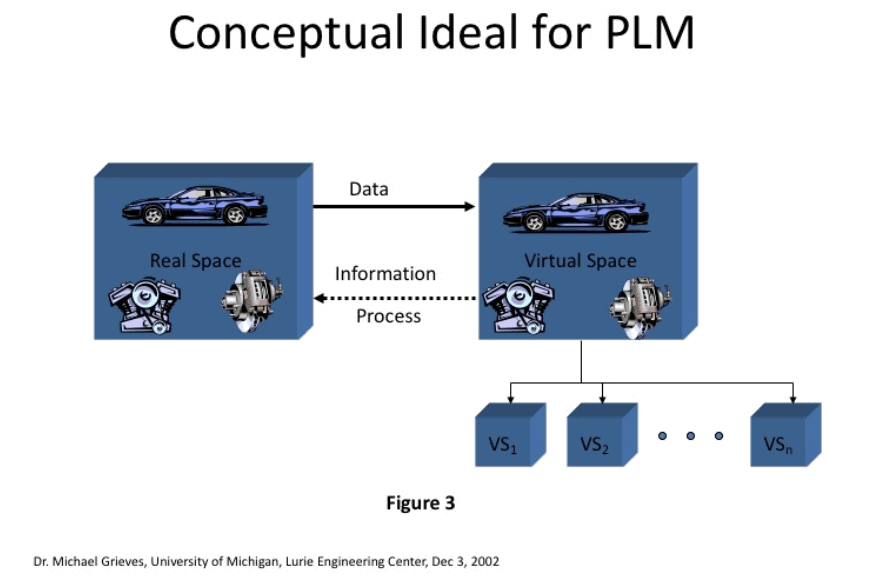
In his treatise On the Soul,[1] Aristotle raises the question on the essence and properties of the soul in terms of an explanation for life. It is, in itself, a treatise on living beings: “the first actuality of a natural body that has life potentially.” In the first chapter of the Second Book, Aristotle uses his Metaphysical doctrine to define the soul as an entity of the living, “understand it, form, essence, and a definition of the living.”
Some 2,350 years later, in early 2002, Professor Michael Grieves from the University of Michigan presented his Mirrored Spaces Model [2], and it was NASA’s John Vickers who used the concept of a Digital Twin to describe his theoretical, conceptual framework of PLM (Product Lifecycle Management).
Referencias
[1] http://eltalondeaquiles.pucp.edu.pe/wp-content/uploads/2015/09/Aristoteles-Acerca-del-alma.-Gredos.-Trad-Tomas-Calvo.pdf
[2]https://www.researchgate.net/publication/306223791_Digital_Twin_Mitigating_Unpredictable_Undesirable_Emergent_Behavior_in_Complex_Systems

This model brings together elements that generally define the concept of the Digital Twin: real space, virtual space, linked corresponding information between the two, and various additional virtual subspaces. Both systems, the real and the virtual one, interact dynamically throughout their relevant lifecycles – that is, they exchange information throughout the stages of design and engineering, execution, operation and maintenance, and finally, closing and deactivation. The definition of a system is quite broad. We can talk about digital models for products[1], equipment and facilities[2], assembly and manufacturing lines[3], and even systems like manufacturing plants[4] or different sociotechnical systems (hospital complexes[5], airports[6], logistics terminals, ports[7], etc.).
In short, the Digital Twin is a virtual model of a physical asset that fully reflects its features, functionalities, and behaviors throughout its lifecycle. Or once again, in the words of Aristotle: “form, essence, and a definition of the living.” A virtual model is the soul of the digital twin; it represents form (configuration), captures essence (the purpose and mission), and defines being (action).
But Aristotle does not stop there. In his work, he goes on to describe the so-called powers of the soul, that is, the faculties regarding nutrition, sentience, decision-making, motor skills, and speech. The strengths of the virtual model make up its abilities for realization: the virtual model is fed (on data and information, as well as human resources, knowledge bases, and economics), collects and records external stimuli (from SCADA[8] systems, IoT, unstructured data sources, etc.), analyzes and offers occurrence scenarios, and acts on the real asset and changes it. Meanwhile, it simultaneously modifies itself (analytical models that configure-experience-analyze-reconfigure and eventually optimize the performance of the real system) to eventually develop and propose the future of its actual counterpart, its living body (decision support systems, or DSS[9], or even automatically acting on parts of the actual system). In any case, the soul, once fed and stimulated, thinks, imagines, and suggests, just as the virtual model simulates different scenarios for configuration, response, and defining actions.
The digital twin: more abilities and scientific evolution
The Digital Twin is another step forward in the evolution of computational environments and capabilities, which have made it possible to extend the scientific method (the observation-hypothesis-experimentation loop) beyond physical models through the simulation of mathematical models that integrate observed data into the real environment and simulated data into the virtual environment. In this sense, it is far from a disruptive approach. Modeling and Simulation[10] methodologies and cyber-physical[11] systems are the mature, expansive bases on which the Digital Twin rests. Both methods are present in areas of high technological intensity that justify their costs, including the defense[12], aerospace[13], automotive[14], and biopharmaceutical[15] fields, to name a few.
And yet, the Digital Twin is an innovative approach in that it represents a change in its typical role and consideration. And this is due to several factors:
- Label. The term “Digital Twin” simplifies the democratization and projection of the term, making an engineering environment that was traditionally the domain of specialists in advanced manufacturing and computing intuitive, and bringing it to the general public. This expansion of the term’s audience creates novel ideas for application.
- Value Context. The Digital Twin acquires all of its power in the context of integration that we call Industry 4.0[16], which generalizes it to any productive field and makes it the conductor of an orchestra of industrial technologies, such as robotics, augmented reality (AR), the IoT, or cloud computing, to name a few, which synergistically achieves economic configurations of scale and utility with a flick of the conductor’s baton. This systemic, integrated vision allows for new functionalities and technology-based value propositions.
- Feasibility. None of the above would come to be if not for the availability of computing capabilities and resources, and the maturity of system architectures and strategies, tools, and data analysis models, as well as the corresponding professional profiles. Lower entry barriers, globalized competitive pressure, and new value levers made possible by Digital Twins in mature markets produce a fertile basis for adoption and continuity.
In short, the Digital Twin is indeed an innovation in that it provides an integrated environment for change and evolution for a system based on profound knowledge. This adds value by enabling higher efficiency and effectiveness in the design and operation of its entire life cycle. And it is without a doubt this last feature, synchronized evolution, that sets the essence and difference of a true Digital Twin apart from any other virtual recreation.
The challenges of the digital twin

However, the challenges that any organization must face when adopting authentic Digital Twins are not trivial. In fact, the digital soul also has its sins and vices, and these, along with its salvation, are recounted in the Gothic literature of the Victorian era. Let’s take a look at three of the masterpieces that reveal three diseases that commonly plague the virtual soul.
- Frankenstein; or, The Modern Prometheus was written by Mary Shelley and published in 1818. The story transports us to a new literary space, where contemporary scientific rigor and narrative fantasy blend into what is said to be the first literary work of science fiction. Obsessive scientist Victor Frankenstein creates a new being from different parts of human corpses, breathing life into his creation through the electric current. However, this body is stitched together from different parts, and even still, the greatest separation the creature feels is from its creator, humankind itself. The monster, once isolated, only responds to a creative fever that does not, however, understand the complexities of a real human being. Frankenstein leads us to reflect on the consequences of the creation and suggestion of isolated, unique bodies that are disconnected from reality and the natural environment. The question of connectivity, both internal and external, that of interoperability, is essential to the conception of the Digital Twin, where a systemic vision geared toward fulfilling a purpose with a determined value must prevail. The Digital Twin is much more than just the sum and connection of models and analysis capabilities in isolation. It is a systematic, iterative, growing process in light of the scale of modeling and simulation for the system in question, capturing and encompassing the intrinsic variability between and the relationships among the very elements of the system itself. This is a participatory process, and the return on investment in a Digital Twin should be shared. Only in this way is it possible to capture the complex nature of production systems.
- The Strange Case of Dr. Jekyll and Mr. Hyde. Robert Louis Stevenson’s novel, published in 1886, raises the question of duality, tension between the social and moral individual, and a being freed from what binds them and from conventions. The respectable Dr. Jekyll comes up with a serum that allows him to take a walk on the dark side of life by being transformed into a totally different being, both physically and morally. Naturally, this invites us to reflect on the importance of coherence and similarity as a fundamental principle in the process of building a Digital Twin. This helps ensure the necessary levels of similarity between the characteristics, functionalities, and behaviors of the elements in the real system and their corresponding reflections in the virtual system. The virtual model must provide the level of granularity, accuracy, and precision required to be able to respond consistently to questions that arise from its counterpart’s performance in the real world. The mechanisms and resources of the organization must be formally defined in order to ensure effective, fluid collaboration between the various professionals who work on the different phases in the life cycle of the Digital Twin. Digital Twins are true non-current assets, real combinations of physical assets and knowledge geared toward their continual use and operation. They are integrated into the organization’s set of operations and systems and are updated, maintained, and a part of the company’s capital.
- The Picture of Dorian Gray: This brilliant work by Oscar Wilde (1890) reflects on an age-old question that none of us can escape: the inexorable passage of time. The novel’s protagonist, Dorian Gray, sells his soul in exchange for eternal youth and beauty. His portrait is what subsequently undergoes the effects of aging, but even more so, moral decline. It captures Gray’s every vice and every fault and capturing them in detail in a pictorial representation of his decrepit, irreconcilable soul. In short, The Portrait of Dorian Gray reverses how reality is reflected. The real object goes unchanged, while its representation, the model, moves farther and farther away from where real life and representation were once similar. The Digital Twin must be the mirror of our real system’s soul. This may be the most common tactical risk, that of obsolescence, which is projected in the operational challenge of While the actual system evolves, a gap grows between it and the reflection of those changes in its virtual counterpart. As such, the conditions of active aging from the same design stage must be ensured, that is, a modular, parametric, accessible design that enables interoperability and updates with changes in the settings and nature of our real system. On the operational plane, the status synchronization system between both systems and response times is critical.
I could conclude with Gartner[17], referencing some of his positive predictions for the future of the digital twin. Nevertheless, I still prefer Aristotle: the soul is the first actuality of a natural body that has life potentially. A body without a soul doesn’t have any real life. Let’s give our assets and processes their souls and never forget that virtue is an excellence of the (digital) soul.
Referencias
[1] https://www.ansys.com/about-ansys/advantage-magazine/volume-xi-issue-1-2017/creating-a-digital-twin-for-a-pump
[2] https://www.ansys.com/about-ansys/advantage-magazine/volume-xi-issue-1-2017/creating-a-digital-twin-for-a-pump
[3] https://www.enertiv.com/solution/enertiv-ai/digital-twin
[4] https://www.spotlightmetal.com/the-digital-twin-in-aircraft-construction-a-855498/
[5] [5]https://umi.udc.es/es/actuaciones/simulacion/
[6] https://uscan.gehealthcarepartners.com/service-about/digital-twin
[7] https://www.internationalairportreview.com/session_detail/94123/case-study-demystifying-the-digital-twin-concept-how-copenhagen-airport-is-utilising-the-concept-for-knowledge-sharing-and-decision-making/
[8] https://www.ibm.com/blogs/internet-of-things/iot-digital-twin-rotterdam/
[9] https://www.investopedia.com/terms/d/decision-support-system.asp
[11] https://www.nist.gov/el/cyber-physical-systems
[12] https://www.navantia.es/en/navantia-4-0/shipyard-4-0/digital-twin/
[14] https://www.nist.gov/el/cyber-physical-systems
[15] https://www.navantia.es/en/navantia-4-0/shipyard-4-0/digital-twin/
[16] https://ntrs.nasa.gov/archive/nasa/casi.ntrs.nasa.gov/20120008178.pdf
[17] https://www.gartner.com/en/newsroom/press-releases/2019-02-20-gartner-survey-reveals-digital-twins-are-entering-mai





There are no comments yet